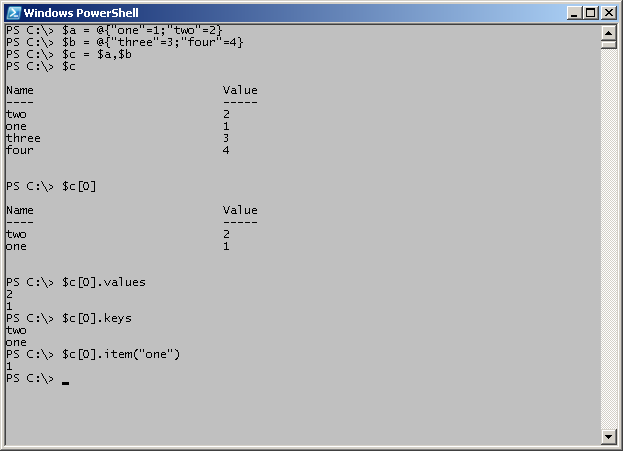Summary: Take your Windows PowerShell scripting to the next level by combining hash tables and arrays.
Microsoft Scripting Guy, Ed Wilson, is here. The Scripting Wife and I are anxiously counting down the days until the first ever Pittsburgh PowerShell Users Group meeting. The event is quickly selling out; therefore, if you want to attend, you will need to sign up for the meeting. The reason for the reservation is that space at the Pittsburgh Microsoft Office is limited. The meeting will be a lot of fun.
This past week, I talked about working with arrays. Although Windows PowerShell makes working arrays very easy, there are still lots of little things that need special attention. The five articles in the series devoted to working with Arrays in Windows PowerShell are listed here:
- In the first post, Learn Simple Ways to Handle Windows PowerShell Arrays, I discussed creating arrays, indexing into arrays, and two techniques for walking through an array.
- In the second post, Add, Modify, Verify, and Sort Your PowerShell Array, I discussed adding, modifying, or verifying values in a Windows PowerShell array, and two easy techniques for sorting the array.
- In the third post, Find the Index Number of a Value in a PowerShell Array, I talked about working with arrays to determine the index number of a given value. In addition, I covered working with one half of the array at a time.
- In the fourth post, I answered a question that was sent to scripter@microsoft.com about reading a CSV file and building distinguished names on the fly by using array notation. The Read a CSV File and Build Distinguished Names on the Fly by Using PowerShell post was really cool, and it presented a practical way to use arrays.
- The last post was Easily Create and Manipulate an Array of Arrays in PowerShell, and I discussed working with an array of arrays.
Today, I want to look at creating an array that contains hash tables. Suppose I create a couple of hash tables, such as the ones that are shown here.
$a = @{“one”=1;”two”=2}
$b = @{“three”=3;”four”=4}
If I want to create an array with these two hash tables, it is as simple as using the equality operator, and assigning them to a variable by using standard array techniques. This command is shown here.
$c = $a,$b
The view of this array of hash tables appears to be a bit strange—it looks like I am looking at a hash table. This is shown here.
PS C:\> $c
Name Value
—- —–
two 2
one 1
three 3
four 4
The cool thing is that I can index into the elements of my array by using square brackets as shown here.
PS C:\> $c[0]
Name Value
—- —–
two 2
one 1
Because each element of the array contains a hash table, I can index into the array, and then use “hash table kinds of commands” such as querying the Keys or Values properties or using the Item method. These commands are shown here.
PS C:\> $c[0].values
2
1
PS C:\> $c[0].keys
two
one
PS C:\> $c[0].item(“one”)
1
The commands that create two hash tables, add the hash tables to an array, and then index into the array to work with the hash tables are shown in the following image.
If I am only interested in the keys that the hash tables contain, I can pipe the array to the Select-Object cmdlet. This technique is shown here.
PS C:\> $c | select keys
Keys
—-
{two, one}
{three, four}
Although the output does contain the keys, it is not the best output. I can clean things up a bit by using the ExpandProperty parameter. This command is shown here.
PS C:\> $c | select -ExpandProperty keys
two
one
three
four
That is about all there is to working with an array of hash tables. Join me tomorrow as I begin a new week with a special guest blog post by Karl Mitschke.
I invite you to follow me on Twitter and Facebook. If you have any questions, send email to me at scripter@microsoft.com, or post your questions on the Official Scripting Guys Forum. See you tomorrow. Until then, peace.
Ed Wilson, Microsoft Scripting Guy


0 comments